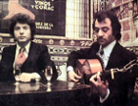Welcome to one of the most active flamenco sites on the Internet. Guests can read most posts but if you want to participate click here to register.
This site is dedicated to the memory of Paco de Lucía, Ron Mitchell, Guy Williams, Linda Elvira, Philip John Lee, Craig Eros, Ben Woods, David Serva and Tom Blackshear who went ahead of us.
We receive 12,200 visitors a month from 200 countries and 1.7 million page impressions a year. To advertise on this site please contact us.
|

|
|
RE: Give us your opinion: Advent of the six-string guitar in flamenco
|
You are logged in as Guest
|
|
Users viewing this topic: none
|
|
Login  | |
|

   
NormanKliman
Posts: 1143
Joined: Sep. 1 2007

|
 RE: Give us your opinion: Advent of ... (in reply to Guest) RE: Give us your opinion: Advent of ... (in reply to Guest)
|
|
|
Romerito:
quote:
Before Montoya and Chacon these songs were really regional and Chacon made incorporated them into his repertoire.
Thanks for all the info you posted. In that sense, I think Chacón did a lot of "codifying" as you say. He repeats letras, temple (vocalization before the letra) and even tercios. I'm not trying to put him down, what I mean is that he sometimes sounds systematic to my ears. For example, in those cantes mineros, he sings the same fourth sung line in all those cantes. Torre, Cojo de Málaga and others used a different kind of melodic arc at that point. The supreme example is Torre's "que me apareje el caballo tordo" from the "espuela" taranto. It's not the only way to handle the fourth sung line, but it's surprising that Chacón never did it that way. Different timeframes, I guess.
quote:
It is possible that there waws a precursor that inspired the Talega's creations...
I thought the consensus was that those cantes existed before Joaquín and that he "lengthened" them. If I remember right, his son Enrique said that in an interview in Rito y Geografía.
Estebanana:
quote:
No, I don't think it's a contradiction because the classical period did not happen until Haydn.
Okay, I understand you.
quote:
There was probably a crossover of court music taking influence from street and folk music and vise versa,
Yeah, that sounds reasonable.
quote:
It was also a shallow fashion statement, but it had a serious undercurrent as well.
And it's fun.  Another good reason for people to play the guitar! Another good reason for people to play the guitar!
quote:
This could explian some of the French love of Flamenco in Ramon Montoya's day because they had been interested in Spanish folk culture as an invader five generations earlier.
Sure: neighboring countries.
quote:
All this is to say these things all happened when Flamenco was beginning to emerge and could have had an effect on the popularity and bringing to the fore of an already existing six string guitar.
Interesting contribution, thanks. And thanks for the Bermudo reference!
quote:
I mean think about it, any idiot in 1555 with a pencil and a rubber band could have fashioned a capo.
Yeah, but you ever try doing that with a piece of string when your capo breaks at a party or something? Never works!  I did it once but haven't been able to repeat it since. I did it once but haven't been able to repeat it since.
_____________________________
Be here now.
|
|
|
|
REPORT THIS POST AS INAPPROPRIATE |
Date Feb. 3 2010 4:06:48
 |
|
 New Messages New Messages |
 No New Messages No New Messages |
 Hot Topic w/ New Messages Hot Topic w/ New Messages |
 Hot Topic w/o New Messages Hot Topic w/o New Messages |
 Locked w/ New Messages Locked w/ New Messages |
 Locked w/o New Messages Locked w/o New Messages |
|
 Post New Thread
Post New Thread
 Reply to Message
Reply to Message
 Post New Poll
Post New Poll
 Submit Vote
Submit Vote
 Delete My Own Post
Delete My Own Post
 Delete My Own Thread
Delete My Own Thread
 Rate Posts
Rate Posts
|
|
|
Forum Software powered by ASP Playground Advanced Edition 2.0.5
Copyright © 2000 - 2003 ASPPlayground.NET |
0.0625 secs.
|


 Printable Version
Printable Version






 Another good reason for people to play the guitar!
Another good reason for people to play the guitar! 

 New Messages
New Messages No New Messages
No New Messages Hot Topic w/ New Messages
Hot Topic w/ New Messages Hot Topic w/o New Messages
Hot Topic w/o New Messages Locked w/ New Messages
Locked w/ New Messages Locked w/o New Messages
Locked w/o New Messages Post New Thread
Post New Thread